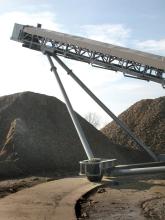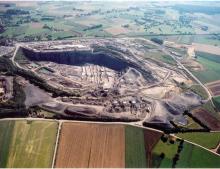
Two years ago the Italian aggregates association identified the need for improvement in organisation and efficiency in the national market. Julie-Anne Ryan takes a look at the progress
The aggregates industry in Italy has never been in danger of monopoly, either by organisation or by region. Its history is one of fragmentation, based on the postwar structure of small pits and quarries satisfying local demand.
What makes Italy different from most other European countries is that it has never really progressed from that structure, never begun to move towards greater control by the international conglomerates. In recent years industry leaders have been working hard to improve things, to find a more efficient future - one that's reflected in the mainstream Italian economy.
It's a slow process, it seems. The state body for national statistics, ISTAT, confirms that there are about 2,460 quarries producing aggregates, and that these belong to about 1,550 companies, which directly employ 14,600 workers.
This figure does not include those workers who are independent contractors. Between them, these quarries produce an estimated 350million tonnes, of which about 60% comes from alluvial deposit cultivation.
Francesco Castagna is general secretary for the Associazione Nazionale Estrattori Produttori Lapidei ed Affini (
The sector is still represented by small, family owned companies that have one or two quarries each. "It is difficult so far to talk about key companies at national level," said Castagna. "What it is possible to say is that, at regional level or at least at departmental level, there are some companies that have increased their business - buying some other quarries, concrete or asphalt plants, recycling and so on - and so far actually they represent the best, and more cost efficient, example of organisation." These small companies have the benefit of being flexible enough to be able to follow the ever-changing requests of the local market and the social requests of the local community, he explained. "They are still benefitting from strong and coherent family management, while they also have a relative financial availability.
In my modest opinion these companies are to become even more important in the market in the near future." There are still problems, of course. It's very difficult for ANEPLA, for example, to try to convince many small companies who are closely linked to their local situation, of the importance of the organisation's work at national and, even more, at European level.
Incidentally, Castagna explained that the industry's state of fragmentation - bearing in mind the market and the general economic situation - isn't in itself a negative thing; it doesn't necessarily represent a loss of efficiency.
"I would say on the contrary that, in our sector, the SMEs often are more cost-efficient than the big companies and much more flexible and ready to listen to the everyday changing requests from the local community," he said. "In a sector so much influenced by the NIMBY syndrome (those who proclaim 'Not In My Back Yard'), you must always be ready to listen to the local community - and a small company, which is a part of the economic and social life of its land and local community, is much more local community oriented than is a simple quarrying site belonging to a multinational cement company." It's been said before that the high number of companies reflects the relatively recent national unity of the country: much of its administration remains regionally fragmented. Small workshop enterprises are a feature of the business culture, but that mentality might be a barrier to moving up to operating on a larger economic scale.
Negotiating the high number of lower level administrations can also present problems, particularly in terms of dealing with the 8,000 or so Italian municipalities when it comes to aggregates extraction licensing. The city of Milan has more than one million inhabitants, and yet there are countless tiny municipalities with their residents numbered not even in hundreds.
All of them have to be dealt with, and all of them have their own rules. Up until two years ago, there were problems with time limits - most licences to extract needed renegotiation after two or three years. "There are still limits," said Castagna. "We are working hard to push a new legislative system that, while not reducing the level of attention we must give to the environment and to the needs of local communities, can offer more guarantees for the investment of the extracting companies. It is impossible to plan an investment when you don't know if the mayor - or a victim of the NIMBY syndrome -will be able to close your activity in two years!" It's this NIMBY collective that is a significant barrier to growth, he believes.
"The general process of progressive decentralisation of our administrative system and its competence will increase NIMBYism even more, and will make life much more difficult for the quarry companies than it has been in the past. So far the public is not supporting our sector in any way. On the contrary, it is trying to put even more pressure on it.
"As a direct consequence of this, our industry is still no closer to being seen as an important player in the mainstream Italian economy," said Castagna.
It will be interesting to see if moves to improve activity in recycling will have any effect on public perception. It has been said that regulation in Italy of how unpolluted ground waste should be treated has always been confusing, and more clarity is also needed in terms of recycling and health and safety.
Castagna said, "There are many companies that are expanding their field of activity in recycling sector - in many cases not because the recycling in itself may be a business but to consolidate the customers." He pointed out the benefits to quarry companies of recycling development, including large loading and storage areas; strategic position in relation to the road network; availability of more dumpers, lorries, belts, screeners; recycled materials to mix with virgin, to improve performance; and a single lorry trip for waste management and raw material.
Such is the strength of interest among quarries in the developing sub sector of construction and demolition waste, and in the experimental area of green energy, that ANEPLA now has special sections dedicated to recycling and to energy.
So while there has not been a huge improvement in the past two years, there are signs of development and progression in some respects. Although Castagna warned, "As long as our legislative and administrative system remains as it is now - and the actual tendency in our state organisation is to give even more importance to the local public bodies, in the name of subsidiarity - I think that nothing will change radically. The only change that I see in the near future is linked to the fact that some old quarries, the traditionally family owned, without generational replacement, are destined to be sold. And so far some of them, but not necessary all, might be purchased by a big multinational cement companies interested in entering in the aggregates business. But this is a slow process and nothing will really change, in my modest opinion, in the near future."










